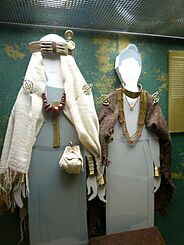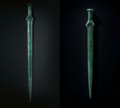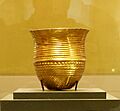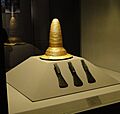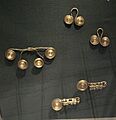Tumulus culture facts for kids
 |
|
| Geographical range | Central Europe |
|---|---|
| Period | Middle Bronze Age |
| Dates | c. 1600–1200 BC |
| Preceded by | Unetice culture, Ottomány culture, Rhône culture, Mad'arovce culture, Encrusted Pottery culture |
| Followed by | Urnfield culture, Lusatian culture |
| Central European Bronze Age | |
| Late Bronze Age | |
| Ha B2/3 | 950–800 BC |
| Ha B1 | 1050–950 BC |
| Ha A2 | 1100–1050 BC |
| Ha A1 | 1200–1100 BC |
| Bz D | 1300–1200 BC |
| Middle Bronze Age | |
| Bz C2 | 1400–1300 BC |
| Bz C1 | 1500–1400 BC |
| Bz B | 1600–1500 BC |
| Early Bronze Age | |
| Bz A2 | 2000–1600 BC |
| Bz A1 | 2300–2000 BC |
The Tumulus culture (German: Hügelgräberkultur) was the dominant material culture in Central Europe during the Middle Bronze Age (c. 1600 to 1300 BC).
It was the descendant of the Unetice culture. Its heartland was the area previously occupied by the Unetice culture, and its territory included parts of Germany, the Czech Republic, Austria, Switzerland, the Carpathian Basin, Poland and France. It was succeeded by the Late Bronze Age Urnfield culture and part of the origin of the Italic and Celtic cultures.
Artefacts and characteristics
The Tumulus culture is distinguished by the practice of burying the dead beneath burial mounds (tumuli or kurgans).
In 1902, Paul Reinecke distinguished a number of cultural horizons based on research of Bronze Age hoards and tumuli in periods covered by these cultural horizons are shown in the table below (right). The Tumulus culture was prevalent during the Bronze Age periods B, C1, and C2. Tumuli have been used elsewhere in Europe from the Stone Age to the Iron Age; the term "Tumulus culture" specifically refers to the South German variant of the Bronze Age. In the table, Ha designates Hallstatt. Archaeological horizons Hallstatt A–B are part of the Bronze Age Urnfield culture, while horizons Hallstatt C–D are the type site for the Iron Age Hallstatt culture.
The Tumulus culture was eminently a warrior society, which expanded with new chiefdoms eastward into the Carpathian Basin (up to the river Tisza), and northward into Polish and Central European Únětice territories. The culture's dispersed settlements consisted of villages or homesteads centered on fortified structures such as hillforts. Significant fortified settlements include the Heuneburg, Bullenheimer Berg, Ehrenbürg, and Bernstorf. Fortification walls were built from wood, stone and clay. The massive 3.6m-wide wall surrounding the plateau of the Ehrenbürg resembled later murus gallicus fortifications known from the Iron Age. 'Cyclopean' stone fortifications topped with wooden battlements were constructed c. 1400 BC at the large hillfort of Stätteberg in Bavaria.
Tumulus culture societies traded with those in Scandinavia, Atlantic Europe, the Mediterranean region and the Aegean. Traded items included amber and metal artefacts. From the beginning of the Middle Bronze Age there is evidence for the use of weighed metal as form of payment or money. Weighing equipment has been found in central Europe dating from c. 1400 BC onwards.
Some scholars see Tumulus groups from southern Germany as corresponding to a community that shared an extinct Indo-European linguistic entity, such as the hypothetical Italo-Celtic group that was ancestral to Italic and Celtic. This particular hypothesis, however, conflicts with suggestions by other Indo-Europeanists. For instance, David W. Anthony suggests that Proto-Italic (and perhaps also Proto-Celtic) speakers could have entered Northern Italy at an earlier stage, from the east (e.g., the Balkan/Adriatic region).
The Bronze Hand of Prêles from Switzerland, dating from the 16th-15th century BC, is a unique find from the Tumulus culture period. Described as "the earliest metal representation of a human body part ever found in Europe", it may have been a ritual object, or mounted on a standard like similar metal hands known from the Iron Age, or possibly a prosthesis. It was found in a grave along with a bronze hair-ring, pin and dagger. The hand had a golden bracelet or cuff decorated with solar motifs.
Golden hats from Schifferstadt in Germany and Avanton in France, dating from the late Tumulus period (c. 1400 BC), may have been worn by elite religious figures, described as 'oracles' or 'king-priests' by researchers. The patterns of ornaments or symbols on the hats are thought to represent calendars, as on the later and more elaborate Berlin Gold Hat, which may encode knowledge of the luni-solar Metonic cycle. Gold discs from the Czech Republic, dating from c. 1650-1250 BC, feature similar ornaments and are thought to represent simpler calendars. Identical 'ritual objects' from Haschendorf in Austria and Balkåkra in Sweden may also date from the Middle Bronze Age and have been interpreted as solar calendars.
Gallery
-
Gold disc, Czechia, c.1650 BC.
-
Avanton gold hat, France, c. 1400 BC
-
Tumulus ceramics, Hagenau, France
-
Horse bits made from antler, Germany
See also
- Bernstorf fortified settlement
- Bronze hand of Prêles
- Bell Beaker culture
- Frankleben hoard
- Urnfield culture
- Nordic Bronze Age
- Bronze Age Britain
- Argaric culture
- Ottomany culture
- Vatya culture
- Wietenberg culture
- Srubnaya culture
- Mycenaean Greece
- Atlantic Bronze Age
- Terramare culture
- Apennine culture


